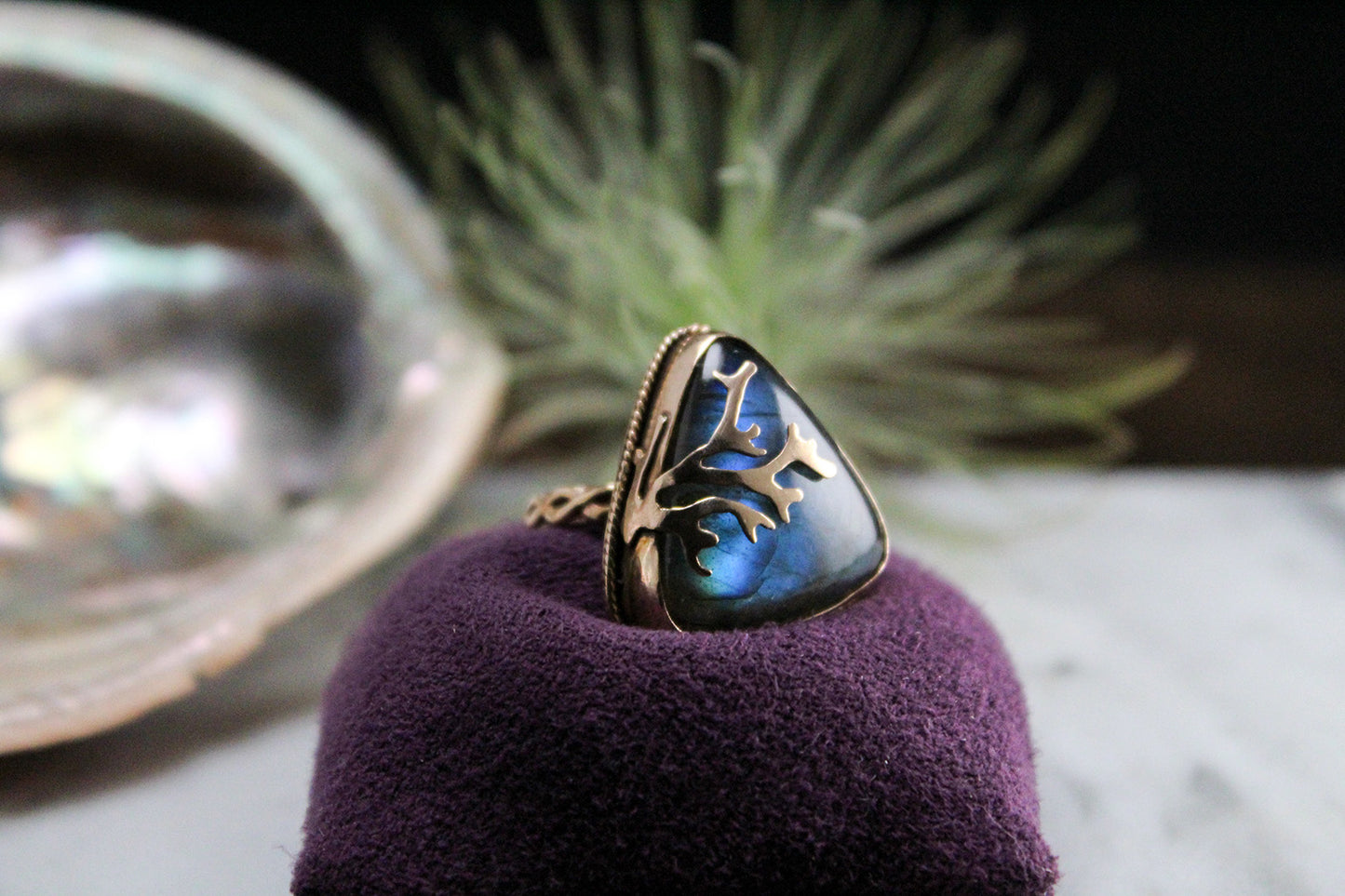
Featuring the shimmering blues and greens of Labradorite, the Coral Dreams collection is inspired by the beauty and critical importance of the coral reefs of the planet in an effort to bring more awareness to this issue, not just for my island home but the impact it has on everyone on earth.
Delicate branches wrap around the iridescent sheen of the stone, echoing the rippling depths of the sea. Hand sawn elements and custom-built settings showcase the brilliant flash Labradorite is known for. These dreamy pieces evoke the watery softness the ocean provides. They are a metaphor in the making – as fragile as they are beautiful, just like the reef.
Coral reefs are diverse underwater ecosystems formed of colonies of tiny animals found in marine waters called coral polyps, held together by calcium carbonate. They occupy less than 0.1% of the world's ocean area, yet they provide a home for at least 25% of all marine species. They form some of the world's most productive ecosystems, providing complex and varied marine habitats that support a wide range of other organisms. Over half a billion people depend on reefs for food, income, and protection. Coral reef structures also buffer shorelines against 97 percent of the energy from waves, storms, and floods, helping to prevent loss of life, property damage, and erosion.

There are several things that currently threaten coral reefs, like physical damage from destructive fishing practices and recreational misuse, but increasing ocean temperatures and changing ocean chemistry are the greatest threats to these ecosystems. Corals are very sensitive to these changes. When seawater temperature rises, the corals lose the microscopic algae that produces their food, stressing the corals. This causes a condition known as coral bleaching. Some corals can take a very long time to recover, especially in Hawaii, so when bleaching occurs - if it is prolonged - it can eradicate coral colonies permanently. Coral reef decline can be permanent or temporary, depending on its resilience, and there are efforts being made to identify the best way to help them recover after bleaching occurs.
There is a very detailed study in Hawaii that I will link below, but essentially it talked about some of the key ways we can, as a world community, help support initiatives that will make a difference.
- Preventing Additional Damage to Coral - protecting coral reef areas from stressors which may compound the effect of a bleaching event. Examples of these stressors could include overfishing, land-based pollution, or physical breakage from boats, trampling, etc. Preventing additional damage to coral allows for the natural recovery of dead or damaged corals. Supporting the creation of a network of permanent no-take Marine Protected Areas (MPAs) and the additional actions to prevent damage including the reduction of harmful sediment, nutrients, and other pollutants.
- Controlling Algal Overgrowth - Controlling algal overgrowth allows for the settlement of new coral recruits and helps to prevent excessive algae. Preventing overgrowth prevents reefs from becoming dominated by algae that inhibit coral growth and can lead to substantially better outcomes for resident corals. The protection of herbivores, especially parrotfish, has been cited as being critical to effective management. Parrotfish play multiple ecological functions in coral recovery, including controlling algal overgrowth and creating new space for coral. Protection of herbivores from fishing pressure has been projected to delay rates of coral loss even under the most extreme bleaching.
- Stimulating New Coral Settlement - Early coral life stages are particularly vulnerable to human stressors, so focusing on land-based pollution may also be a strategy to promote settlement of coral larvae.
- Stimulating New Coral Growth – Is about creating conditions under which remnant coral that has survived the bleaching event can rapidly regrow and populate the dead area. There have been natural phenomenons witnessed where remnant coral can rapidly regrow but more research is needed in this area.
- Replacing Dead Coral - Replacing the coral killed by a bleaching event with new coral from another location is fairly new restoration method. Replacement corals are grown in a nursery and then transplanted to the effected area. There are groups developing new ways to get coral to regrow quickly after damage, such as Microfragmentation. Coral grows at different rates in different areas of the world. Whereas a piece of coral make be able to regrow back in 10 years in florida, it may take 50 years in Hawaii. This developing process of microfragmentation is speeding up the process, regrowing coral at a rate of 6 months instead of 20 years. Here is a great video talking about this. An organization working on this here in Hawaii is Kuleana Coral.
Some ways you can help:
Plant Trees - Planting trees can help reduce the runoff that goes into the water, as well as help limit the increase in planet temperatures which can trigger bleaching events in coral.
Consider making your lawn care Green – Runoff from fertilizers are washed into the drains and eventually make their way to the ocean, polluting the water and harming the coral.
Always use reef-friendly sunscreen – avoid products with oxybenzone or octinoxate.
Take care of Trash – Even if it isn’t yours, don’t leave any trash behind. If you see it, pick it up and dispose of it so it doesn’t end up in waterways and oceans.
If you are a business in Hawaii, you could also take the ‘Coral Pledge’:
https://dlnr.hawaii.gov/dar/coral-pledge/
~Any action is better than no action ~
These are some of the links/resources referenced:
https://dlnr.hawaii.gov/dar/coral-pledge/
https://oceanservice.noaa.gov/education/tutorial_corals/coral07_importance.html
https://dlnr.hawaii.gov/dar/files/2017/04/Coral_Bleaching_Recovery_Plan_final.pdf
https://www.nature.org/content/dam/tnc/nature/en/documents/TNC-Caribbean-CMBP-ParrotfishMagazine.pdf

